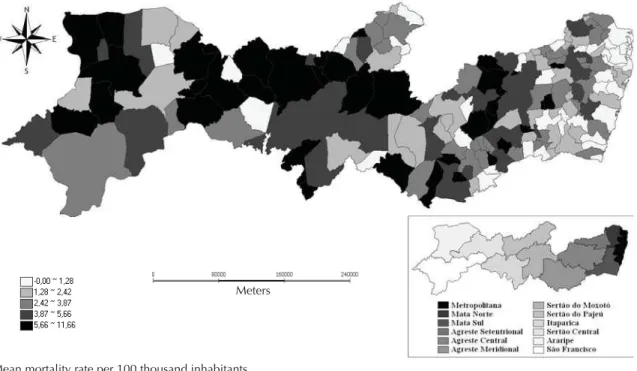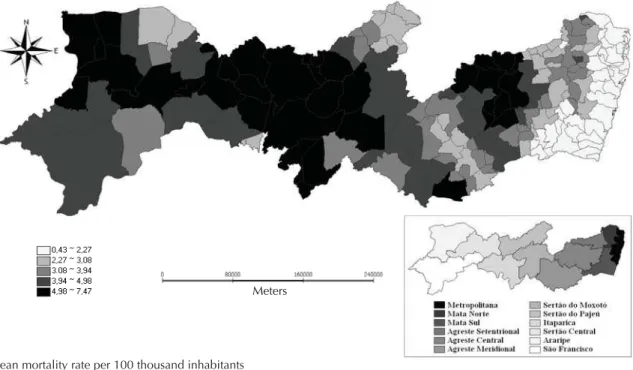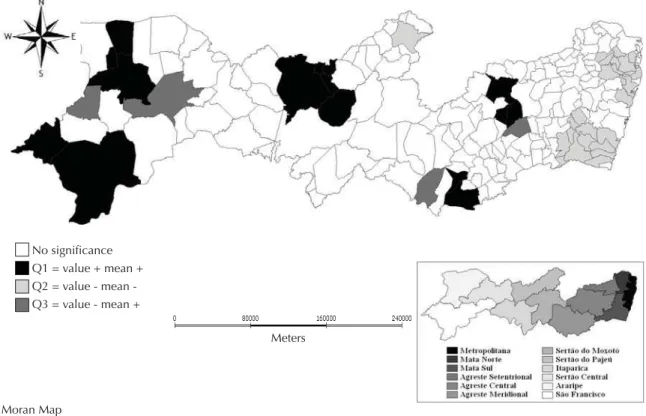Paul Hindenburg Nobre de Vasconcelos SilvaI
Maria Luiza Carvalho de LimaI,II
Rafael da Silveira MoreiraI
Wayner Vieira de SouzaI
Amanda Priscila de Santana CabralIII
I Departamento de Saúde Coletiva. Centro de Pesquisas Aggeu Magalhães. Fundação Oswaldo Cruz. Recife, PE, Brasil II Departamento de Medicina Social.
Universidade Federal de Pernambuco. Recife, PE, Brasil
III Departamento de Vigilância e Saúde. Secretaria de Saúde da Cidade do Recife. Recife, PE, Brasil
Correspondence:
Paul Hindenburg Nobre de Vasconcelos Silva R. Caio Pereira, 390 – apto 702
Rosarinho
52041-010 Recife, PE, Brasil E-mail: paulnobre@cpqam.fi ocruz.br Received: 3/3/2010
Approved: 8/25/2010
Article available from: www.scielo.br/rsp
Spatial study of mortality
in motorcycle accidents in
the State of Pernambuco,
Northeastern Brazil
ABSTRACT
OBJECTIVE: To analyze the spatial distribution of mortality due to motorcycle accidents in the state of Pernambuco, Northeastern Brazil.
METHODS: A population-based ecological study using data on mortality in motorcycle accidents from 01/01/2000 to 12/31/2005. The analysis units were the municipalities. For the spatial distribution analysis, an average mortality rate was calculated, using deaths from motorcycle accidents recorded in the Mortality Information System as the numerator, and as the denominator the population of the mid-period. Spatial analysis techniques, mortality smoothing coeffi cient estimate by the local empirical Bayesian method and Moran scatterplot, applied to the digital cartographic base of Pernambuco were used.
RESULTS: The average mortality rate for motorcycle accidents in Pernambuco was 3.47 per 100 thousand inhabitants. Of the 185 municipalities, 16 were part of fi ve clusters identifi ed with average mortality rates ranging from 5.66 to 11.66 per 100 thousand inhabitants, and were considered critical areas. Three clusters are located in the area known as sertão and two in the agreste of the state.
CONCLUSIONS: The risk of dying from a motorcycle accident is greater in conglomerate areas outside the metropolitan axis, and intervention measures should consider the economic, social and cultural contexts.
DESCRIPTORS: Motorcycles. Accidents, Traffi c, mortality. Ecological Studies.
INTRODUCTION
Transport accidents are “epidemic” in societies today and enter the public health agenda along with morbidity and mortality from external causes.
Motorcycle riders stand out among the victims of transport accidents in Brazil. The use of motorcycles for transportation and labor increases signifi cantly and rapidly, especially in the interior of the Northeastern Brazil. The mortality rate for this category has been rising sharply since the mid-1990s.8,10 The mortality
rate for motorcycle riders went up 875% between 1996 (0.4/100,000 inhabitants) and 2006 (3.9/100,000 inhabitants) in the state of Pernambuco, Northeastern.8,a
Motoboy couriers and mototaxis are new forms of employment and paid passenger transportation increas-ingly used by businesses and individuals.
Detecting areas where such accidents happen can be the fi rst step to help develop intervention measures.5
Techniques of geographic distribution and spatial statistic knowledge are important tools for epidemio-logical studies of accidents. Spatial analysis techniques allow the identifi cation of sites with greater risk of accidents so as to defi ne spatial clusters of events as particular focus of high incidenceb or of high-intensity
events. Thus, this study aimed at analyzing the spatial distribution of mortality due to motorcycle accidents in the state of Pernambuco.
METHODS
Population-based ecological study using data on mortality in motorcycle accidents in the state of Pernambuco from January 1st, 2000 to December 31, 2005.
The analysis units consisted of the municipali-ties and development regions in the state, namely: Metropolitana; Mata Norte, Mata Sul, Agreste Setentrional, Agreste Meridional, Agreste Central, Sertão do Pajeú, Sertão do Moxotó, Sertão de Itaparica, Sertão Central Sertão do São Francisco, Sertão do Araripe. This regionalization takes into account common aspects regarding culture, politics, economy and territory of each cluster of municipalities, according to State Law No. 12,427 of 9/25/2003.
We included all deaths from transport accidents in the group “motorcycle rider injured in transport accident” (V20-29) of the International Classifi cation of Diseases 10th revision (ICD-10), as registered in the Sistema
de Informação sobre Mortalidade (SIM – Brazilian Mortality Information System) among residents of the state of Pernambuco.
The average mortality rates were reached using as the numerator the number of deaths in motorcycle accidents and as the denominator the mid-period population (as of 12/31/2002). For the census years, the reference population was based on the estimated population for municipalities given by the Instituto Brasileiro de Geografi a e Estatística (IBGE – Brazilian Institute of Geography and Statistics). We used spatial analysis techniques, smoothing coeffi cient by the local empirical Bayesian method and the Moran scatterplot, applied to the digital cartographic base of the state.
So as to correct random fl uctuations in small populations or small occurrence numbers, we re-estimated mortality
b Knox EG. Detection of clusters. In: Elliot P, editor. Methodology of enquiries into disease clustering. London: London School of Hygiene and Tropical Medicine; 1988; p.7-16.
c Câmara G, Carvalho MS, Cruz OG, Correia V. Análise espacial de áreas. In: Druck S, Carvalho MS, Câmara G, Monteiro AVM, editores. Análise espacial de dados geográfi cos. Brasília, DF: Embrapa; 2004. p.01-44.
rates using the local empirical Bayesian method under the assumption that rates in surrounding areas are autocorrelated. These areas had their rates re-estimated using the weighted average of the measured value and the average rate in surrounding areas, with weights inversely proportional to the population in each area.2,3,c
Moran’s index is used to summarize the spatial distribution of data, identifying clusters of areas with similar risks for occurrence of the outcome of analysis. Conceptually, this index ranges from -1 to 1: values near zero indicate a lack of spatial correlation - the difference between neighbors; positive values indicate positive spatial autocorrelation, i.e. the existence of similarities between neighboring municipalities; and negative values represent negative spacial autocor-relation. Moran’s index was used to analyze the extent to which the level of a variable in an area is similar to that in neighboring areas.9
Critical areas and areas of transition were identifi ed with the Moran scatterplot, used to compare the values of each municipality studied with the neighboring municipalities’ and to visualize spatial dependence, and the spatial patterns.
The quadrants generated by this technique are inter-preted as follows: Q1 (Positive values, positive means) and Q2 (Negative values, negative means), indicating points of positive spatial association or of similarities among neighboring areas; Q3 (Positive values, nega-tive means) and Q4 (Neganega-tive values, posinega-tive means), indicating points of negative spatial association, i.e., municipalities which have different values from neigh-boring areas.
Cluster areas of motorcycle accidents were identifi ed in the following steps:
1. Location of areas that have positive spatial relation-ship (Q1), given by values in the Moran scatterplot, and visually represented by BoxMAP;
2. Construction of the MoranMAP considering the areas that have a positive spatial relationship iden-tifi ed by BoxMAP and with a spacial signifi cance equal to or below 5%.
Municipalities enclosed in the MoranMAP Q1 class were considered critical areas.
The exploratory spatial analysis seeking to identify the transition areas and the critical areas of the studied events were carried out on Excel©spreadsheets and
on the TerraView version 3.14.© software. The results
RESULTS
The average mortality rate for motorcycle accidents in the state of Pernambuco was 3.47 per 100 thousand inhabitants. We identifi ed fi ve critical areas formed by 16 of the 185 municipalities in the state. These areas had mortality rates ranging from 5.66 to 11.66/100,000 inhabitants, higher than the state average. Two of these areas were located in developing regions of the Pernambuco Agreste and the other three in developing regions of the Sertão. The municipality of Calumbi, situated in the Pajeú Sertão, had the highest motorcycle mortality rate, nine times higher than that reported in Recife (the state capital), where there is a higher number of vehicles in circulation.
The municipalities with the lowest values were located in developing regions of the Mata Sul and Mata Norte, and in the Metropolitan region (Figure 1).
The coefficient correction by the local empirical Bayesian estimate smoothed the areas, specifying the municipalities with higher mortality rates in motorcycle accidents, located in developing regions in the Sertão and sub-areas in the Agreste (Figure 2).
Q1 municipalities were located in the developing regions of the Agreste and of the Sertão, and the transitional areas (Q3 and Q4) in the vicinity of the Recife Metropolitan Region (in the coast) and in developing regions of the Sertão of the state, respectively (Figure 3) .
Clusters with a statistical signifi cance of 5% were iden-tifi ed using information from the Moran Map (Figure 4). Three clusters located in the developing regions of the Sertão of Pernambuco and two developing regions of the Agreste of the state were considered critical locations. These clusters comprise the municipalities of Ouricuri, Trindade and Ipubi, in the developing region of the Sertão do Araripe; Serra Talhada, Santa Cruz da Baixa Verde, Triunfo, Calumbi e Betânia, in the developing regions of the Sertão do Pajeú and the Sertão do Moxotó; Petrolina, Afrânio and Lagoa Grande, in the developing region of the Sertão do São Francisco; and Brejo, Tacaimbó, São Caetano, Saloá and Bom Conselho, in the developing regions of the Agreste Central and Meridional of Pernambuco (Figure 4).
DISCUSSION
The study identifi ed areas of Pernambuco in which motorcycle accident mortality is higher, particularly in the municipalities located in the developing regions of the Agreste and Sertão. This exploratory stage becomes strategic for the prevention and reduction of morbidity and mortality by highlighting the need for research on the social determinants in these critical areas, in these clusters.6 Moreover, the aspects that differentiate the
accidents in which the motorcycle is used as working tool from those in which it is restricted to a means of transportation must be investigated.
Meters
Figure 1. Mean mortality rate due to motorcycle accidents per 100 thousand inhabitants. Pernambuco, Northeastern Brazil,
2000-2005.
The tranquility of small and medium sized cities has been broken with the arrival of “the modern”. Transportation technologies help transform social life,
provide greater well-being, facilitate and reduce the travel time, and bring people together, but also lead many others to death, with a high cost to society. The Meters
Figure 2. Mean mortality rate due to motorcycle accidents estimated by the local empirical Bayesian method. Pernambuco,
Northeastern Brazil, 2000-2005.
Mean mortality rate per 100 thousand inhabitants
Meters Q1 = value + mean +
Q2 = value mean Q3 = value + mean -Q4 = value - mean +
Figure 3. Spatial distribution in Moran’s scatterplot of the mortality rate due to motorcycle accidents (Box Map). Pernambuco,
areas listed as critical are those near the most signifi cant economic movements.
The answer to this phenomenon, coming from common sense, as is often the case with the media and the consti-tuted authorities, is directed to the culpability of the victim. They believe that education, law enforcement and engineering will solve the problem of traffi c accidents. However, the day-to-day reality shows that addressing the issues of violence in traffi c orientated by the triad man-vehicle-track is obsolete. Souza et ald claim that the
violence, including traffi c violence, is not a disease for which one has a specifi c medicine. It is part of human relationships and the dynamics of society: it dramatizes social issues. Societal actions towards democracy and inclusion seem to be, historically, the best solution. According to Mello Jorge,7 when studying the genesis
of traffi c violence “one is faced with a multifaceted and pluriform event, which involves various kinds of factors, making it clear that any approach to be made to that effect should be intersectoral and multidisciplinary”.
Specific actions aimed at changing motorcyclist behavior have little effect,11 since traffi c accidents with
motorcyclists are not just related to driving behavior. They are about the milieu and the market rules estab-lished by employers and clients.
The production of motorcycles in Brazil grew by almost 600% from 1996 (288,073 units) to 2008 (2,004,815), according to the Brazilian Association of Manufacturers of Motorcycles, Mopeds and Similar Vehicles. The increase in the national motorcyclist mortality rate per 100,000 inhabitants in the period 1996-2006 followed this curve: 660%, but reached 875% in Pernambuco. However, the growth in motorcycle production seen throughout the country and also in Pernambuco should not be taken as the sole explanation for the increase in motorcycle accidents. One of the limitations of this study is an inability to identify the critical points of accidents within each municipality, given that risk is not homogeneous throughout.
The prevention of occupational and traffi c accidents is traditionally based on the concept of “behavioral safety”, in which obedience to rules is suffi cient to reduce accidents. This conception is dominant even among experts in the industry and hegemonic in common sense. Thus, unsafe acts and unsafe conditions would be the cause of accidents.¹ Recent studies show limitations of these models that leave out “the causes of the causes” of accidents and “inhibit effective preven-tion practices”.4 It is necessary to enlarge conceptually
the analysis of accident determinants, replacing the Meters
No significance Q1 = value + mean + Q2 = value mean -Q3 = value - mean +
Figure 4. Critical zones for motorcycle accidents identifi ed by the Moran’s scatterplot diagram with 5% statistical signifi cance
(Moran Map). Pernambuco, Northeastern Brazil, 2000-2005. Moran Map
dominant paradigms, for others such as: a systemic view and complex thought used in the theoretical model developed by Macías.e
It is believed that in modern times, this is the path able to reveal suitable alternatives to reduce traffi c accidents, especially those involving motorcycles.
e Macías GR. A complexidade da situação epidemiológica dos acidentes de trânsito [Doctoral thesis]. Salvador: Instituto de Saúde Coletiva da Universidade Federal da Bahia; 2009.
1. Almeida IM. Trajetória da análise de acidentes: o paradigma tradicional e os primórdios da ampliação da análise. Interface Comum Saude
Educ. 2006;10(19):185-202.
DOI:10.1590/S1414-32832006000100013
2. Assunção RM, Barreto SM, Guerra HL, Sakurai E. Mapas de taxas epidemiológicas: uma abordagem bayesiana. Cad Saúde Publica. 1998; 14(4):713-23. DOI:10.1590/S0102-311X1998000400013
3. Bailey TC, Gatrell AC. Interactive spatial data analysis. Harlow: Longman Scientifi c & Technical; 1995. 4. Diniz EPH, Assunção AA, Lima FPA. Prevenção
de acidentes: o reconhecimento das estratégias operatórias dos motociclistas profi ssionais como base para a negociação de acordo coletivo. Cienc Saude
Coletiva.
2005;10(4):905-16.DOI:10.1590/S1413-81232005000400014
5. Jones K, Moon G. Health, disease and society: a critical medical geography. London: Routledge and Kegan Paul; 1987.
6. Kilsztajn S, Silva CRL, Silva DF, Michelin AC, Carvalho AR, Ferraz ILB. Taxa de mortalidade por acidente de trânsito e frota de veículos. Rev Saude
Publica. 2001;35(3):262-8.
DOI:10.1590/S0034-89102001000300008
7. Mello Jorge MHP. À guisa de conclusão. Rev Saude
Publica. 1997;31(4 Supl):51-4.
DOI:10.1590/S0034-89101997000500006
8. Mello Jorge MHP, Koizumi MS. Acidentes de trânsito no Brasil: um atlas de sua distribuição. São Paulo: ABRAMET; 2007.
9. Santos L, Raia Junior AA. Análise espacial de dados geográfi cos: a utilização da Exploratory Spatial Data Analysis - ESDApara identifi cação de áreas críticas de acidentes de trânsito no município de São Carlos(SP).
Soc Natur. 2006;18(35):97-107.
10. Souza MFM, Malta DC, Conceição GMS, Silva MMA, Gazal-Carvalho C, Morais Neto OL. Análise descritiva e de tendência de acidentes terrestres para políticas sociais no Brasil. Epidemiol Serv Saude. 2007; 16(1):33-44.
11. Veronese AM, Oliveira DLLC. Os riscos dos acidentes de trânsito na perspectiva dos motoboys: subsídios para a promoção da saúde. Cad Saude
Publica. 2006;22(12):2717-21.
DOI:10.1590/S0102-311X2006001200021
REFERENCES


